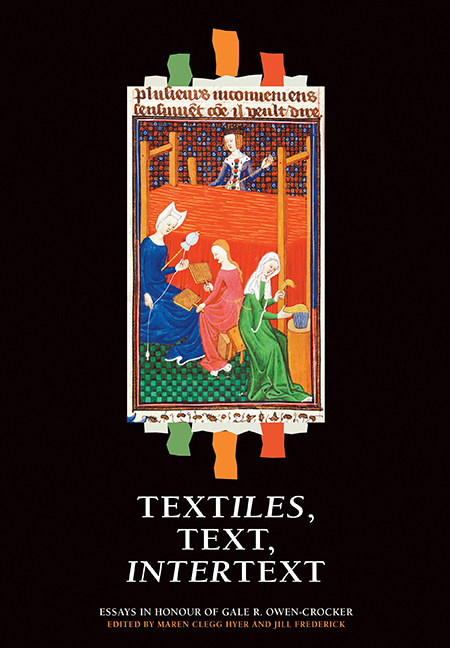Book contents
- Frontmatter
- Contents
- List of Illustrations
- List of Abbreviations
- Introduction
- A Personal Recollection
- List of publications of Gale R. Owen Crocker
- Part I Textile
- 1 The Language of Dress and Textiles in Wills of the Old English Period
- 2 Opus What? The Textual History of Medieval Embroidery Terms and Their Relationship to the Surviving Embroideries c. 800–1400
- 3 Intertextuality in the Bayeux Tapestry: The Form and Function of Dress and Clothing
- 4 Birds of a Feather: Magpies in the Bayeux Tapestry?
- 5 Threads and Needles: The Use of Textiles for Medical Purposes
- Part II Text
- Part III Intertext
- Index
- Tabula Gratulatoria
3 - Intertextuality in the Bayeux Tapestry: The Form and Function of Dress and Clothing
from Part I - Textile
Published online by Cambridge University Press: 05 July 2016
- Frontmatter
- Contents
- List of Illustrations
- List of Abbreviations
- Introduction
- A Personal Recollection
- List of publications of Gale R. Owen Crocker
- Part I Textile
- 1 The Language of Dress and Textiles in Wills of the Old English Period
- 2 Opus What? The Textual History of Medieval Embroidery Terms and Their Relationship to the Surviving Embroideries c. 800–1400
- 3 Intertextuality in the Bayeux Tapestry: The Form and Function of Dress and Clothing
- 4 Birds of a Feather: Magpies in the Bayeux Tapestry?
- 5 Threads and Needles: The Use of Textiles for Medical Purposes
- Part II Text
- Part III Intertext
- Index
- Tabula Gratulatoria
Summary
It is no surprise that the Bayeux Tapestry is celebrated as a work of art, a timeless masterpiece of medieval embroidery. To the modern mind it is aesthetically pleasing. Few fail to be impressed by its length, bright colours, and amusing characters – though undoubtedly its age (near on 1,000 years old) adds considerably to its appeal. The fact that the Tapestry appears cartoonlike (and therefore readily accessible to a modern viewer) is captivating. For British people, in particular, the events shown are well-known: the Norman Conquest of 1066 is taught in all English state (government-funded) schools as part of the “national curriculum”. Thus, British visitors to the Bayeux Tapestry Museum are familiar with the period of history being “performed” before them. Harold is like an old friend in a school photograph, who when spotted is greeted with a spontaneous “There he is!” The familiarity of the Tapestry is also emphasized by popular culture, which makes play of its design, mostly for commerce and satire: even those who have not seen it “in the flesh” will feel as if they know it, so widely is its imagery used. The Bayeux Tapestry also epitomizes the rivalry between England and France, although it is the Normans, not the French, that appear in its imagery. Everything perceived to be good and humble about the Anglo-Saxons (English) is trodden down and destroyed by these posh, wine-drinking Continentals: the Tapestry plays well with the English national psyche and England's love/hate relationship with its closest foreign neighbour.
Although the Bayeux Tapestry, once described as “the greatest English monument abroad”, has an important place in British culture, history, and heritage, little certain is known about it. We do not even know (for sure) if the designer was an Anglo-Saxon or Norman, or even from somewhere else, as some have suggested. Given that we have no historical records to say who the designer was, or why or where the work was made, one might well question how it is possible to “get inside” the mind of its creator.
Elsewhere I have examined the inspiration behind the Tapestry's design, exploring how both contemporary manuscript art and – to a lesser extent – “real life” impacted upon it.
- Type
- Chapter
- Information
- Textiles, Text, IntertextEssays in Honour of Gale R. Owen-Crocker, pp. 69 - 84Publisher: Boydell & BrewerPrint publication year: 2016



